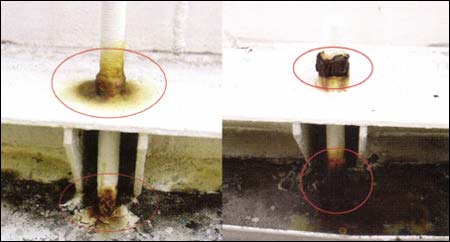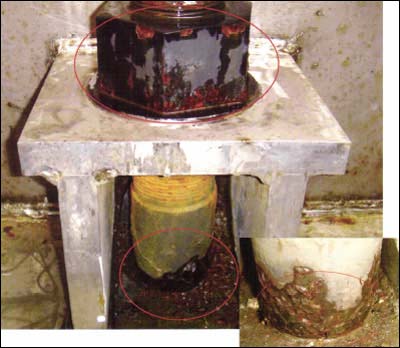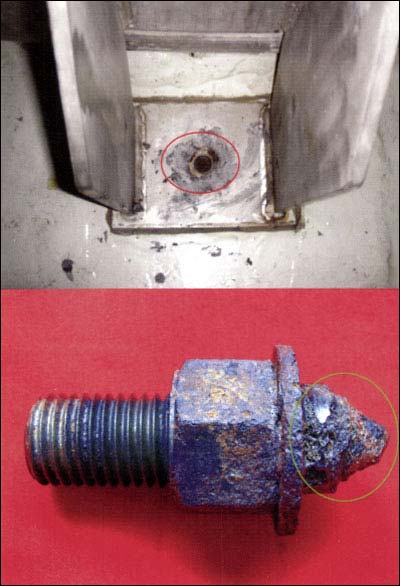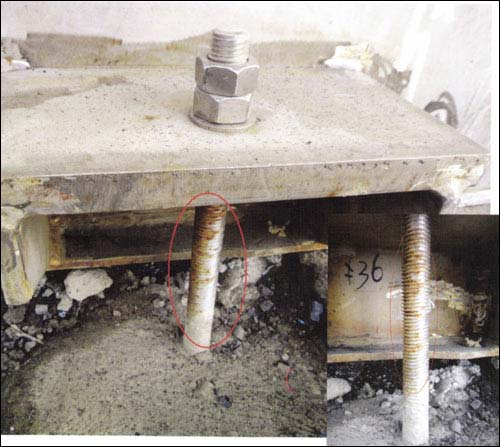The anchor bolts are an important supporting part of the large-scale equipment of the nuclear power plant, and the anchor bolts of some important equipments also have seismic requirements. Once corrosion failure occurs, it will bring serious safety hazards and even affect the safe operation of the power station. The anchor bolts are located at the bottom of the tank. Due to structural reasons, corrosive media such as rainwater and pickling liquid can easily collect and concentrate at the anchor bolts, forming a harsh corrosive environment. The severe corrosive environment causes the corrosion of the anchor bolts, posing a great threat to the normal use of the equipment and the safe operation of the power station.
This paper analyzes the corrosion cases of anchor bolts in a nuclear power plant in China, and combines the situation of a nuclear power plant under construction in China, and puts forward corresponding corrosion prevention measures and anti-corrosion management ideas.
Corrosion case analysis
Corrosion at the joint
In March 2006, when the civil works of a power station was inspected for corrosion status, it was found that the anchor bolts of the demineralized water removal system showed more serious corrosion, and some of the joints of the anchor bolts and the ground were rusted by nearly one-third. If the anchor bolt corrosion is further aggravated, it will affect the stability and shock resistance of the equipment. The corrosion profile of the anchor bolt is shown in Figure 1.

Figure 1 Corrosion morphology of the salt water tank anchor bolt
When inspecting the refueling water tank of the fuel pool cooling and purification system, it was found that the surface coating of the anchor bolt nut peeled off and peeled off, and the exposed metal was corroded, which was reddish brown and yellow. There is a gap between the screw and the bottom of the tank, and there is water. Here, the surface coating of the screw is cracked and peeled, the partial coating is peeled off, and the exposed metal is corroded, showing a reddish brown rust spot, as shown in FIG. 2 .

Figure 2 Corrosion of the anchor bolts of the refueling tank
It can be seen from the above two cases that the corrosion mainly occurs at the interface between her foot bolts and the concrete floor and the reinforcing plate. The main mode of corrosion is crevice corrosion. When the anchor bolt is installed, there is a gap between the screw and the bolt hole and no sealing measures are taken, which causes the corrosive medium to gather at the place and cause corrosion. The joint between the anchor bolt and the concrete ground does not take drainage measures, and the corrosive medium such as rainwater It is difficult to discharge by itself after entering, and salt and solid particles in the atmosphere are deposited here, which increases the conductance and corrosivity, resulting in corrosion of the screw.
Corrosion caused by residual acid wash
In August 2010, when the static machine personnel performed the anchor bolt torque check on the waste resin tank of the waste liquid treatment system during the execution work, it was found that one anchor bolt was completely broken, the fracture was tapered, and the surface was heavily brownish corroded. The product is covered, and there are residual brown corrosion products in the bolt holes. The macroscopic appearance is shown in Fig. 3.

Figure 3 Corrosion morphology of the waste resin box anchor bolt
During the inspection of the cooler purifying degassing storage and processing system container, it was found that the four anchor bolts were completely broken. As shown in Fig. 4, there were two fractures when the bolt moment was checked. The residual connection before the rectification moment was found only at the fracture observation. 2mm.

Figure 4 The overall shape of the anchor bolt fracture
Through the analysis of corrosion products and on-site conditions, the anchor bolt corrosion is mainly caused by the penetration into the anchor bolt holes during the pickling and passivation treatment, resulting in an aggressive environment, and the pickling solution corrodes the bolts. The gap between the outer surface of the bolt and the inner surface of the screw hole is about 1 mm, and the gap between the bolt and the concrete is smaller. As the bolt corrodes in the residual liquid, the corrosion products in the gap gather, and the gap environment is easily formed. The grounding feet are made of stainless steel, and the anchor bolts are XG18 low-alloy steel. When there is an electrolyte solution (such as pickling solution), galvanic corrosion of large cathode and small anode will occur, and the formation of corrosion products accelerates the occurrence of crevice corrosion.
Problems in the construction phase of the project
There is a lot of water in the anchor bolt pool
On March 18, 2011, during the on-site inspection of the demineralized water tank of a dewatering distribution system of a power station under construction in China, it was found that the 12 anchor bolts of the two water tanks were initially positioned at the installation site, and a large amount of rainwater remained in the pit pool. Steel corrosion is obvious, as shown in Figure 5.

Figure 5 Anchor bolt and round steel corrosion
Anchor bolts show significant rust
The anchor bolt pool position is lower than the surrounding tank base position, and rainwater, pickling liquid, etc. are easily collected at the anchor bolt position. On May 31, 2011, after more than one month of installation of the anchor bolts, it was found that the desiccant tank anchor bolts had been installed and some of the anchor bolts had obvious rust, as shown in Figure 6.

Figure 6 Desalination tank anchor bolt corrosion
Corrosion control method
Material selection
(1) Under the premise of meeting the requirements of strength and toughness, select materials with better corrosion resistance and better performance, such as stainless steel and corrosion resistant alloy steel.
(2) The same material should be used as much as possible for anchor bolts, nuts, gaskets, and embedded round steel to avoid galvanic corrosion. Preferably, the gasket is made of an insulating gasket of sufficient strength.
(3) Strictly check the material in the acceptance stage of the material to prevent materials with material defects, machining defects, corrosion protection defects, etc. from being used in the power station.
Prevent crevice corrosion
To prevent crevice corrosion, the following measures can be taken: adding expansion rubber at the gap of the bolt; applying anti-rust oil to the gap of the bolt; pouring paraffin into the gap between the bolt and the concrete floor, and preserving the part of the anchor bolt exposed to the ground with paint Wait.
When applying anti-rust oil to the gap of the bolt, it is necessary to apply it all at all, and a reasonable inspection mechanism should be established to prevent the preventive measures from failing due to the evaporation of the anti-rust oil.
Prevent installation stress
During the concrete pouring of the anchor bolt pit pool, the anchor bolts should be fixed vertically. The concrete is poured out on both sides to the middle at the same time, and the material around the bolt is as uniform as possible, so that the concrete surface around it rises evenly to avoid excessive height difference. The vibrator should be kept at an appropriate distance between the vibrating rod and the bolt. Insert it symmetrically and evenly to avoid displacement and deflection caused by the impact bolt and the bracket.
After the pouring is completed, tracking and measurement should be carried out to understand the changes of the pre-embedded bolts during concrete pouring, and adjust the measurement results in real time to avoid the bolt displacement and inclination, resulting in installation stress after the installation is completed.
Corrosive media
(1) Covering measures should be taken before the anchor bolt holes are poured to prevent rainwater and flushing water from entering the gap.
(2) After the installation of the anchor bolts is completed, anti-corrosion treatment should be carried out in time. Usually paint or rust preventive oil is used.
(3) When the stainless steel equipment is pickled and passivated, the anchor bolt and its surrounding area should be effectively protected to prevent the pickling liquid from entering the anchor bolt gap, and the corrosion hazard can be buried. The wax seal can be used for pickling. Passivation treatment.
Conclusion
The corrosion problem of anchor bolts was once the focus of power station. However, the current practice is generally to pay attention to the problem after the anchor bolts have serious corrosion problems and lose their functions. When there was no serious corrosion problem during the construction phase of the project, it did not cause great attention from all aspects of the power station. To fundamentally solve the corrosion problem of anchor bolts, it is necessary to study and analyze the feasibility of anti-corrosion and waterproofing methods on site according to the overall structure of the equipment and the corrosive environment, and select appropriate corrosion control methods to eliminate corrosion hazards. And establish a sound corrosion management system and corrosion inspection program, regularly check the integrity of the anti-corrosion measures and the corrosion of the anchor bolts. If necessary, the non-destructive testing method can be used for detailed inspection, and the found anti-corrosion measures and bolt body The corrosion condition is treated as a defect.
Installed on the kitchen sink, used to a mixture of hot and cold water. Its structure includes: screw lift type, metal ball valve type, ceramic spool type, etc. The faucet valve body is made of brass, chrome-plated, gold-plated and various metal lacquers. The shape is various, the handle has a single, double handle of the points. Gold Kitchen Faucets or chrome kitchen faucets are provided, also the rose gold faucets.
Cold Water Faucet,Hot And Cold Tap,Hot And Cold Outdoor Faucet,Hot Cold Tap
Kaiping Jianfa Sanitary Ware Co Ltd , https://www.jfsanitary.com